
Effect of climate change on plant biodiversity
Encyclopedia
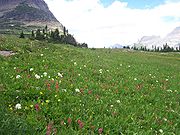
Range (biology)
In biology, the range or distribution of a species is the geographical area within which that species can be found. Within that range, dispersion is variation in local density.The term is often qualified:...
of plants, in combination with other factors. Changes in long term environmental conditions that can be collectively coined climate change
Climate change
Climate change is a significant and lasting change in the statistical distribution of weather patterns over periods ranging from decades to millions of years. It may be a change in average weather conditions or the distribution of events around that average...
are known to have had enormous impacts on plant diversity patterns in the past and are seen as having significant current impacts. It is predicted that climate change will remain one of the major drivers of biodiversity
Biodiversity
Biodiversity is the degree of variation of life forms within a given ecosystem, biome, or an entire planet. Biodiversity is a measure of the health of ecosystems. Biodiversity is in part a function of climate. In terrestrial habitats, tropical regions are typically rich whereas polar regions...
patterns in the future.
Palaeo context
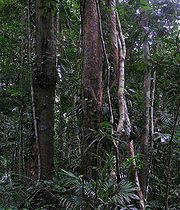
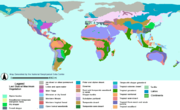
Earth
Earth is the third planet from the Sun, and the densest and fifth-largest of the eight planets in the Solar System. It is also the largest of the Solar System's four terrestrial planets...
has experienced a constantly changing climate
Climate
Climate encompasses the statistics of temperature, humidity, atmospheric pressure, wind, rainfall, atmospheric particle count and other meteorological elemental measurements in a given region over long periods...
in the time since plants first evolved. In comparison to the present day, this history has seen Earth as cooler, warmer, drier and wetter, and CO2 (carbon dioxide
Carbon dioxide
Carbon dioxide is a naturally occurring chemical compound composed of two oxygen atoms covalently bonded to a single carbon atom...
) concentrations have been both higher and lower. These changes have been reflected by constantly shifting vegetation
Vegetation
Vegetation is a general term for the plant life of a region; it refers to the ground cover provided by plants. It is a general term, without specific reference to particular taxa, life forms, structure, spatial extent, or any other specific botanical or geographic characteristics. It is broader...
, for example forest
Forest
A forest, also referred to as a wood or the woods, is an area with a high density of trees. As with cities, depending where you are in the world, what is considered a forest may vary significantly in size and have various classification according to how and what of the forest is composed...
communities dominating most areas in interglacial
Interglacial
An Interglacial period is a geological interval of warmer global average temperature lasting thousands of years that separates consecutive glacial periods within an ice age...
periods, and herbaceous
Herbaceous plant
A herbaceous plant is a plant that has leaves and stems that die down at the end of the growing season to the soil level. They have no persistent woody stem above ground...
communities dominating during glacial periods. It is has been shown that past climatic change has been a major driver of the processes of speciation
Speciation
Speciation is the evolutionary process by which new biological species arise. The biologist Orator F. Cook seems to have been the first to coin the term 'speciation' for the splitting of lineages or 'cladogenesis,' as opposed to 'anagenesis' or 'phyletic evolution' occurring within lineages...
and extinction
Extinction
In biology and ecology, extinction is the end of an organism or of a group of organisms , normally a species. The moment of extinction is generally considered to be the death of the last individual of the species, although the capacity to breed and recover may have been lost before this point...
. The best known example of this is the Carboniferous Rainforest Collapse
Carboniferous Rainforest Collapse
The Carboniferous Rainforest Collapse was an extinction event that occurred around 305 million years ago in the Carboniferous period). Vast coal forests covered the equatorial region of Euramerica...
which occurred 350 million years ago. This event decimated amphibian populations and spurred on the evolution of reptiles.
Modern Context
There is significant current interest and research focus on the phenomenon of recent anthropogenic climate changes, or global warmingGlobal warming
Global warming refers to the rising average temperature of Earth's atmosphere and oceans and its projected continuation. In the last 100 years, Earth's average surface temperature increased by about with about two thirds of the increase occurring over just the last three decades...
. Focus is on identifying the current impacts of climate change on biodiversity, and predicting these effects into the future.
Changing climatic variables relevant to the function and distribution of plants include increasing CO2 concentrations, increasing global temperatures, altered precipitation
Precipitation (meteorology)
In meteorology, precipitation In meteorology, precipitation In meteorology, precipitation (also known as one of the classes of hydrometeors, which are atmospheric water phenomena is any product of the condensation of atmospheric water vapor that falls under gravity. The main forms of precipitation...
patterns, and changes in the pattern of ‘extreme’ weather events such as cyclones, fires or storms.
Because individual plants and therefore species can only function physiologically
Plant physiology
Plant physiology is a subdiscipline of botany concerned with the functioning, or physiology, of plants. Closely related fields include plant morphology , plant ecology , phytochemistry , cell biology, and molecular biology.Fundamental processes such as photosynthesis, respiration, plant nutrition,...
, and successfully complete their life cycles under specific environmental conditions (ideally within a subset of these), changes to climate are likely to have significant impacts on plants from the level of the individual right through to the level of the ecosystem or biome
Biome
Biomes are climatically and geographically defined as similar climatic conditions on the Earth, such as communities of plants, animals, and soil organisms, and are often referred to as ecosystems. Some parts of the earth have more or less the same kind of abiotic and biotic factors spread over a...
].
Effects of CO2
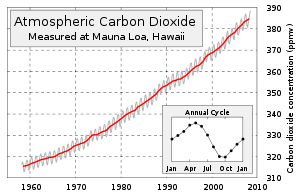
Photosynthesis
Photosynthesis is a chemical process that converts carbon dioxide into organic compounds, especially sugars, using the energy from sunlight. Photosynthesis occurs in plants, algae, and many species of bacteria, but not in archaea. Photosynthetic organisms are called photoautotrophs, since they can...
e, resulting in increases in plant water use efficiency, enhanced photosynthetic capacity and increased growth. Increased CO2 has been implicated in ‘vegetation thickening’ which affects plant community
Community (ecology)
In ecology, a community is an assemblage of two or more populations of different species occupying the same geographical area. The term community has a variety of uses...
structure and function. Depending on environment, there are differential responses to elevated atmospheric CO2 between major ‘functional types’ of plant, such as and
C4 carbon fixation
C4 carbon fixation is one of three biochemical mechanisms, along with and CAM photosynthesis, used in carbon fixation. It is named for the 4-carbon molecule present in the first product of carbon fixation in these plants, in contrast to the 3-carbon molecule products in plants. fixation is an...
plants, or more or less woody species; which has the potential among other things to alter competition between these groups. Increased CO2 can also lead to increased Carbon : Nitrogen ratios
Carbon to nitrogen ratio
The C/N ratio or carbon-to-nitrogen ratio is a ratio of the mass of carbon to the mass of nitrogen in a substance. It can, amongst other things, be used in analysing sediments and compost...
in the leaves of plants or in other aspects of leaf chemistry, possibly changing herbivore
Herbivore
Herbivores are organisms that are anatomically and physiologically adapted to eat plant-based foods. Herbivory is a form of consumption in which an organism principally eats autotrophs such as plants, algae and photosynthesizing bacteria. More generally, organisms that feed on autotrophs in...
nutrition.
Effects of temperature

Effects of water
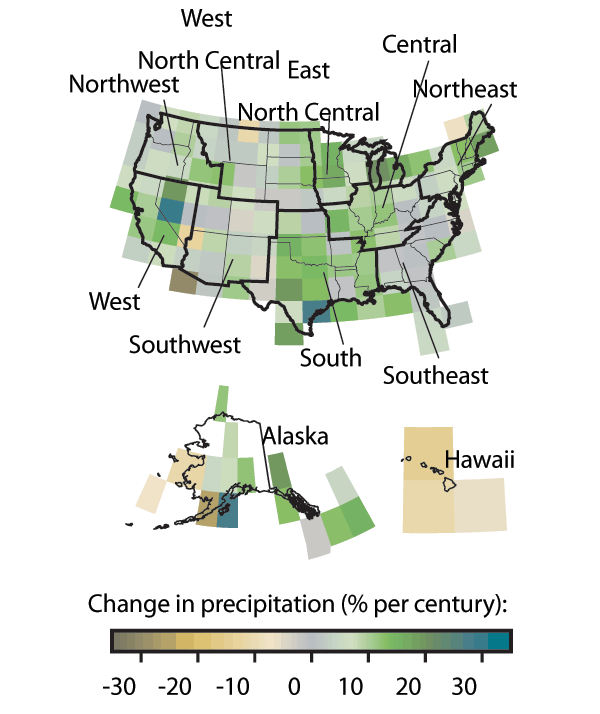
Precipitation (meteorology)
In meteorology, precipitation In meteorology, precipitation In meteorology, precipitation (also known as one of the classes of hydrometeors, which are atmospheric water phenomena is any product of the condensation of atmospheric water vapor that falls under gravity. The main forms of precipitation...
are predicted to be less consistent than for temperature and more variable between regions, with predictions for some areas to become much wetter, and some much drier.
General effects
Environmental variables will not act in isolation, but also in combination with one other, and with other pressures such as habitatHabitat
* Habitat , a place where a species lives and grows*Human habitat, a place where humans live, work or play** Space habitat, a space station intended as a permanent settlement...
degradation and loss or the introduction of exotic species. It is suggested that that these other drivers of biodiversity change will act in synergy with climate change to increase the pressure on species to survive.
Changes in distributions
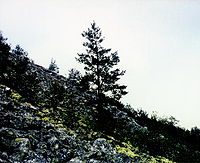
Temperature
Temperature is a physical property of matter that quantitatively expresses the common notions of hot and cold. Objects of low temperature are cold, while various degrees of higher temperatures are referred to as warm or hot...
and precipitation
Precipitation (meteorology)
In meteorology, precipitation In meteorology, precipitation In meteorology, precipitation (also known as one of the classes of hydrometeors, which are atmospheric water phenomena is any product of the condensation of atmospheric water vapor that falls under gravity. The main forms of precipitation...
change in a region beyond the tolerance of a species phenotypic plasticity
Phenotypic plasticity
Phenotypic plasticity is the ability of an organism to change its phenotype in response to changes in the environment. Such plasticity in some cases expresses as several highly morphologically distinct results; in other cases, a continuous norm of reaction describes the functional interrelationship...
, then distribution changes of the species may be inevitable. There is already strong evidence that plant species are shifting their ranges in altitude and latitude as a response to changing regional climates.
When compared to the reported past migration rates of plant species, the rapid pace of current change has the potential to not only alter species distributions, but also render many species as unable to follow the climate to which they are adapted. The environmental conditions required by some species, such as those in alpine regions may disappear altogether. The result of these changes is likely to be a rapid increase in extinction risk. Adaptation
Adaptation
An adaptation in biology is a trait with a current functional role in the life history of an organism that is maintained and evolved by means of natural selection. An adaptation refers to both the current state of being adapted and to the dynamic evolutionary process that leads to the adaptation....
to new conditions may also be of great importance in the response of plants.
Predicting the extinction risk of plant species is not easy however. Estimations from particular periods of rapid climatic change in the past have shown relatively little species extinction in some regions, for example. Knowledge of how species may adapt or persist in the face of rapid change is still relatively limited.
Changes in the suitability of a habitat for a species drive distributional changes by not only changing the area that a species can physiologically tolerate, but how effectively it can compete with other plants within this area. Changes in community composition are therefore also an expected product of climate change.
Changes in life-cycles (phenology)
The timing of phenologicalPhenology
Phenology is the study of periodic plant and animal life cycle events and how these are influenced by seasonal and interannual variations in climate...
events such as flowering are often related to environmental variables such as temperature. Changing environments are therefore expected to lead to changes in life cycle events, and these have been recorded for many species of plants. These changes have the potential to lead to the asynchrony between species, or to change competition between plants. Flowering times in British plants for example have changed, leading to annual plants flowering earlier than perennials, and insect pollinated plants flowering earlier than wind pollinated plants; with potential ecological consequences. A recently published study has used data recorded by the writer and naturalist Henry David Thoreau
Henry David Thoreau
Henry David Thoreau was an American author, poet, philosopher, abolitionist, naturalist, tax resister, development critic, surveyor, historian, and leading transcendentalist...
to confirm effects of climate change on the phenology of some species in the area of Concord, Massachusetts
Massachusetts
The Commonwealth of Massachusetts is a state in the New England region of the northeastern United States of America. It is bordered by Rhode Island and Connecticut to the south, New York to the west, and Vermont and New Hampshire to the north; at its east lies the Atlantic Ocean. As of the 2010...
.
Indirect impacts of climate change
All species are likely to be not only directly impacted by the changes in environmental conditions discussed above, but also indirectly through their interactions with other species. While direct impacts may be easier to predict and conceptualise, it is likely that indirect impacts are be equally important in determining the response of plants to climate change.A species whose distribution changes as a direct result of climate change may ‘invade’ the range of another species for example, introducing a new competitive relationship.
The range of a symbiotic fungi associated with plant roots may directly change as a result of altered climate, resulting in a change in the plants distribution.
A new grass may spread into a region, altering the fire regime and greatly changing the species composition.
A pathogen or parasite may change its interactions with a plant, such as a pathogenic fungus becoming more common in an area where rainfall increases.
Increased temperatures may allow herbivores to expand further into alpine regions, significant impacting the composition of alpine herbfield
Herbfield
Herbfields are plant communities dominated by herbaceous plants, especially forbs and grasses. They are found where climatic conditions do not allow large woody plants to grow, such as in subantarctic and alpine tundra environments...
s.
There are innumerable examples of how climate change could indirectly affect plant species, most of which will be extremely difficult to predict.
Higher level changes
Species respond in very different ways to climate change. Variation in the distribution, phenology and abundance of species will lead to inevitable changes in the relative abundance of species and their interactions. These changes will flow on to affect the structure and function of ecosystems.Challenges of modelling future impacts
Accurate predictions of the future impacts of climate change on plant diversity are critical to the development of conservation strategies. These predictions have come largely from bioinformatic strategies, involving modelling individual species, groups of species such as ‘functional types’, communities, ecosystems or biomes. They can also involve modelling species observed environmental nichesEcological niche
In ecology, a niche is a term describing the relational position of a species or population in its ecosystem to each other; e.g. a dolphin could potentially be in another ecological niche from one that travels in a different pod if the members of these pods utilize significantly different food...
, or observed physiological processes.
Although useful, modelling has many limitations. Firstly, there is uncertainty about the future levels of greenhouse gas emissions driving climate change and considerable uncertainty in modelling
Global climate model
A General Circulation Model is a mathematical model of the general circulation of a planetary atmosphere or ocean and based on the Navier–Stokes equations on a rotating sphere with thermodynamic terms for various energy sources . These equations are the basis for complex computer programs commonly...
how this will affect other aspects of climate such as local rainfall or temperatures. For most species the importance of specific climatic variables in defining distribution (e.g. minimum rainfall or maximum temperature) is unknown. It is also difficult to know which aspects of a particular climatic variable are most biologically relevant, such as average vs. maximum or minimum temperatures. Ecological processes such as interactions between species and dispersal rates and distances are also inherently complex, further complicating predictions.
Improvement of models is an active area of research, with new models attempting to take factors such as life-history traits of species or processes such as migration into account when predicting distribution changes; though possible trade-offs between regional accuracy and generality are recognised.
Climate change is also predicted to interact with other drivers of biodiversity change such as habitat destruction and fragmentation, or the introduction of foreign species. These threats may possibly act in synergy
Synergy
Synergy may be defined as two or more things functioning together to produce a result not independently obtainable.The term synergy comes from the Greek word from , , meaning "working together".-Definitions and usages:...
to increase extinction risk from that seen in periods of rapid climate change in the past.
See also
- Global warmingGlobal warmingGlobal warming refers to the rising average temperature of Earth's atmosphere and oceans and its projected continuation. In the last 100 years, Earth's average surface temperature increased by about with about two thirds of the increase occurring over just the last three decades...
- BiodiversityBiodiversityBiodiversity is the degree of variation of life forms within a given ecosystem, biome, or an entire planet. Biodiversity is a measure of the health of ecosystems. Biodiversity is in part a function of climate. In terrestrial habitats, tropical regions are typically rich whereas polar regions...
- BiogeochemistryBiogeochemistryBiogeochemistry is the scientific discipline that involves the study of the chemical, physical, geological, and biological processes and reactions that govern the composition of the natural environment...
- DesertificationDesertificationDesertification is the degradation of land in drylands. Caused by a variety of factors, such as climate change and human activities, desertification is one of the most significant global environmental problems.-Definitions:...
- Extinction risk from climate changeExtinction risk from climate changeThe extinction risk of global warming is the risk species have of becoming extinct due to the effects of global warming.-Current projections:The scientific consensus in the IPCC Fourth Assessment Report is that...
- Effects of climate change on marine mammalsEffects of climate change on marine mammalsClimate change is a cause of increasing concern to scientists and it will have dramatic effects on marine mammals. The increase of carbon dioxide and other greenhouse gases into the atmosphere are thought to be the main cause of climate change or global warming...
- Physical impacts of climate changePhysical impacts of climate changeThis article is about the physical impacts of climate change. For some of these physical impacts, their effect on social and economic systems are also described.-Definition of climate change:This article refers to reports produced by the IPCC...
- Systems ecologySystems ecologySystems ecology is an interdisciplinary field of ecology, taking a holistic approach to the study of ecological systems, especially ecosystems. Systems ecology can be seen as an application of general systems theory to ecology. Central to the systems ecology approach is the idea that an ecosystem...
External links
- (2008) Government report on the effects of climate change on agriculture, land resources, water resources, and biodiversity in the United States.
- (2003) Summary report from an international conference on Global Climate Change and Biodiversity.
- (2008) Discussion on the future of modeling climate change impacts on plant species distributions.
- (2005) The Millennium Ecosystem Assessment, including discussion of the effects of climate change on biodiversity
- Global Change Biology - a scientific journal with articles relating to the interaction between global changes such as climate, and biological systems
- (2011) After the birds vanish, the plants are next to go - New ScientistNew ScientistNew Scientist is a weekly non-peer-reviewed English-language international science magazine, which since 1996 has also run a website, covering recent developments in science and technology for a general audience. Founded in 1956, it is published by Reed Business Information Ltd, a subsidiary of...

